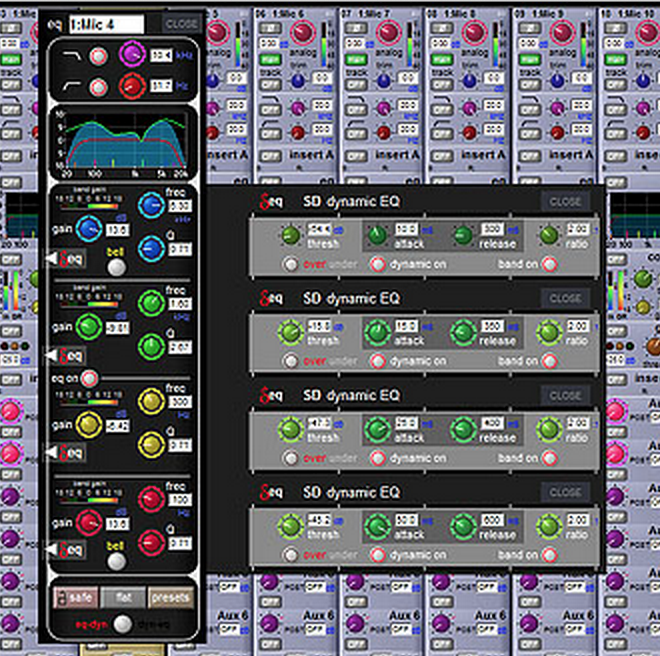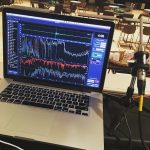
My Own Preset

One of the more frustrating things I find with a lot of digital consoles these days are the “default” input settings. Some consoles have really narrow EQ’s. Some have really wide ones. The initial frequency points are often interesting as well. And the dynamics…I’m not even going to go there, but I’m not surprised a lot of newer engineers struggle to figure them out based on some of the default settings I see.
So one of the first things I often do these days when I’m on a new desk is build my own preset for an input. This gets settings in a ballpark for where I expect things to be so I can work a lot faster. I’ll typically name it with either a “!” or “00” as the first characters so it sorts to the top of the presets. That way when I hit an input where I need to zero things, I just load my preset and go.
Outside of this one preset, I don’t really have presets for individual stuff, though. I might start building a library of vocalists and speakers if I’m mixing repeatedly for the same client, but if I have my preset I can usually work fast enough. The key in creating a preset is to pick YOUR favorite settings. Here are roughly the settings I use, but that doesn’t mean they’ll work for you.
1. Filters
I used to start with the HPF on since I use it on most things, but right now I’m starting with all filters off. I bet I’ll change that within the next 6 months, though, because everything is constantly evolving for me. 80 Hz is a nice setting to start on most things, though, and there usually isn’t much that’s musical beyond 12k on stuff where I would use a LPF. I rarely leave stick with these settings on an input, but they aren’t usually far off for me.
2. EQ
Most of the EQ’ing I do on a channel is in the lows and low-mids, and those frequencies work well for me to start. A Q of 1.4 is usually a little more towards the wider side of things, but narrow enough that it’s not sucking a ton out of a sound. Then I have the gain at 0 dB because I don’t want to start with anything happening. I do like starting with all the EQ’s turned on, though, because if the Gain is at 0 a digital EQ shouldn’t change anything.
3. Compressor
The biggest frustration I have with most default compressor settings are the Attack and Release settings, and I usually find the defaults worthless. For me, a 10ms Attack is fast, but usually not so fast that it kills any punch. A 100ms Release is also relatively fast, but not so fast that things will distort a lot. A 3:1 ratio is kind of new for me lately as I’ve been playing with lower ratios a lot more. 3:1 isn’t exactly low, but it’s lighter than the 4:1 I favored for a long time. In terms of the Knee, I just usually prefer hard knee compression. Then the makeup gain is at 0 and the Threshold is as high as it will go so if I want to compress things I can typically just pull the Threshold down and maybe add a little makeup gain. I can then fine tune things a bit if needed from there.
4. Gate
The big setting for me is the low Threshold because it ensures when I pop in a Gate it won’t close to start. Then I can just raise the Threshold until it’s above the noise I’m trying to get rid of. It’s kind of backwards from the way I learned to use a Gate and the way most people think about Gates. So, in other words, instead of trying to set a Threshold to OPEN the Gate, I set the Threshold so the unwanted stuff doesn’t open it. That way I’m not sitting around waiting and waiting and waiting for a drummer to finally play a fill with that one tom.
I set the Range as deep as it will go because I like starting with an actual Gate even though it’s not unusual for me to only use 3-10 dB of Range in some cases. In terms of Attack, these days most Gates I run into don’t click like a lot of analog ones used to on ultra-fast Attack settings so I set that as fast as possible since most of the stuff I use Gates on are transient intensive. A 100ms Release isn’t usually where I need it, but it’s usually an OK starting point for me and shouldn’t completely neuter a floor tom or kick drum. I go back and forth on using the Hold control on gates, but I’m using it more and more in lieu of a long Release these days. In those cases I’ll use the Hold control to get the sustain I want out of stuff and tweak the Release to fine tune and smooth out any noise that’s still bleeding in. Remember, Attack and Release controls are NOT delay controls on compressors and gates; they are speed controls. In the case of a Gate, that Release is sort of my crossfade time to turn an input back down.
As I said, those are just what works for me these days. These settings also have a strong tendency to evolve for me as I grow frustrated with my own starting points over time.
What settings do you like to start with an inputs? What is working for you?

 Previous Post
Previous Post



What inputs would typically get the LPF at 12KHz?
Sometimes vocals. Electric guitars might be a bit lower maybe in the 6-10k range. Bass guitar might be in the 4-6k range. It just depends on the input.